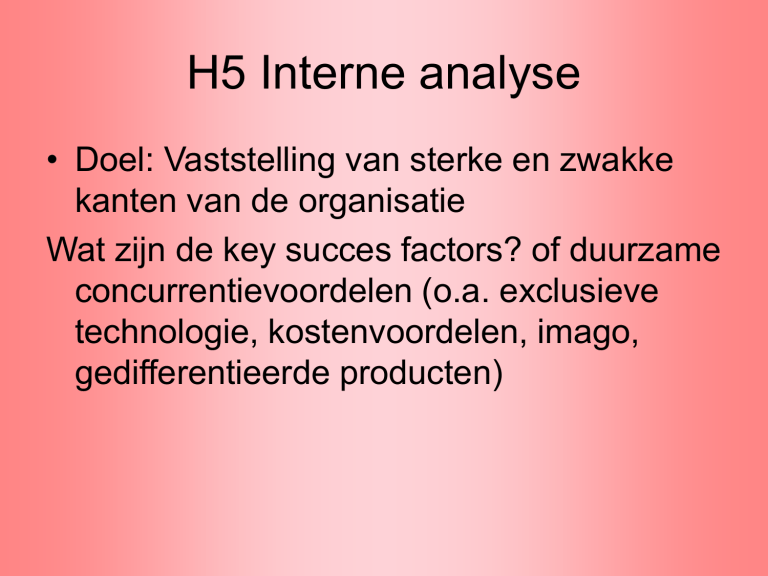
H5 Interne analyse
• Doel: Vaststelling van sterke en zwakke
kanten van de organisatie
Wat zijn de key succes factors? of duurzame
concurrentievoordelen (o.a. exclusieve
technologie, kostenvoordelen, imago,
gedifferentieerde producten)
Prestatie van de onderneming
• Financiële prestaties (volgende hoofdstuk)
• Niet financiële prestaties
FOETSJE
•
•
•
•
•
•
•
Financiële elementen
Organisatorische elementen
Economische elementen
Technologische elementen
Strategische en sociale elementen
Juridische elementen
Ethische en ecologische elementen
Financiële prestaties
• Kosteneffectiviteit
– assortiment 80/20
– productgroepen
– distributie
– inkoop
– make or buy
– synergie (na fusies), resource sharing business units
• Relatieve kostenpositie, leer- en ervaringscurve
• Inzicht in kosten, benchmarking
• Uitsplitsing kosten per activiteit, kostenverdeelstaat
Shared values in organisatie
•
Stevige verankering is belangrijke bijdrage aan succes.
Voorbeelden:
•
integriteit
•
ondernemerschap
•
partnership
•
kwaliteit personeel
•
onafhankelijkheid
•
trots
Management:
1.
constitueren
2.
dirigeren
3.
controleren
Niet financiële Economische
prestaties
•
•
-
Marktpositie, relatief MA en groei
C4 index
Entreedrempels
Jay Curry´s klantenpiramide (zie NIMA A
sheets)
Kwaliteit van producten en diensten
Vendor rating
Kwaliteitsmeting
service
Niet financiële prestaties
Merkproducten met merkwaarde (Aaker)
- Imago
- Bekendheid
- Associaties
- Merkentrouw
- Overige
De 5 'basiseigenschappen' voor de persoonlijkheid van
een merk (Aaker)
1. Oprechtheid
2. opwindendheid
3. bekwaamheid
4. fijnzinnigheid en
5. stoerheid.
Niet financiële prestaties
•
•
-
Afnemerstevredenheid
Spontane merkbekendheid
Geholpen merkbekendheid
Merkentrouw
R&D output
Nieuwe producten
Nieuwe patenten
• CRM
CRM
Customer Relation Management
Een feed-back model, waarbij:
• Klantentrouw leidt tot hoge retentie en
doorverwijzing, dus tot lage transactie- en
acquisitiekosten en dus tot hoge
winstgevendheid en hoge klantwaarde
(customer life-time value)
• en goede info over de klanten leidt tot
productdifferentiatie/maatwerk en tot hoge
klanttevredenheid
Technologie
• Technologie i.h.a. en ICT in het bijzonder
voor veel processen en producten cruciaal
Sociale prestaties
•
-
Management en functionele disciplines
Human resource
Directie of RvB
Samenwerking organisatiedisciplines
Werknemers
Societal marketing
Juridisch en Ecologisch
Juridisch
• patenten, octrooi, merknamen
• leverings- en betalingsvoorwaarden
• vergunningen
• productaansprakelijkheid
Ecologisch/ethisch
Wat is kwaliteit
Opgedane ervaring minus verwachting van
de afnemer
Ideaal: ACE, above customer expectation
Kwaliteitsmodel
• INK
- zelfevaluatiemodel. 10 resultaatgebieden,
5 ondernemingsfasen
- Benchmarking
Analyse instrumenten
•
•
•
•
•
BCG matrix, Boston model (zie NIMA A)
MaBa analyse
Value chain analysis
Mc Kinsey 7 S´en model
Peters & Waterman 8 succesfactoren
MaBa analysis
Market attractiveness
• Market attractiveness
• Business attractivenes/(eigen) concurrentiekracht
N.B. 1. kies de meest relevante factoren voor de case
2. vaak verschillende wijze van berekenen (0 .. 1, of 0 – 100%)
en soms de assen omgedraaid
100
Investeren
66
33
Consolideren
Desinvesteren
0
100 66
33
0
Concurrentiekracht/
businessattract.
MaBa analysis factoren
• Market attractiveness
– marktomvang, marktgroei
– concurrentiedruk
– winstgevendheid
– afnemerstevredenheid
– technologie
– omgeving
– sociaal, politiek, juridisch kader
– trendmatigheid
• Business attractivenes
– omvang, marktaandeel absoluut en relatief, groei
– kwaliteit product, merkreputatie, research
– distributiepositie
– marges
– managementniveau
– communicatiebudget
Value Chain Analysis (Porter)
• Per processtap kosten en differentiatiemogelijkheden analyseren en
benchmarken (mini-SWOT)
• Primaire activiteiten (ingaande logistiek, operations, uitgaande
logistiek, marketing en sales, service)
• Ondersteunende activiteiten (infrastructuur, HRM, Technologische
ontwikkelingen/R&D, verwerving/inkoop)
-
Interne verbindingen (synergie)
Externe verbindingen (met andere waardeketens)
-
Leidt uiteindelijk tot marge/winstgevendheid.
Elke stap moet toegevoegde waard hebben, en zeker geen
AFgevoegde waarde
McKinsey 7 S´en model
1.
2.
3.
4.
5.
6.
7.
Structuur
Strategie
Systemen en procedures
Stijl van het management
Sleutelvaardigheden (core competence)
Staf
Significante waarden
(organisatiecultuur), shared values
Excellente ondernemingen
volgens Peters & Waterman
Succesvol management
1.
Actiegerichte oriëntatie
2.
Klantgerichte instelling
3.
Autonomie en ondernemersgeest
4.
Productiviteit door inzet van mensen
5.
Persoonlijke inzet en waardebewustzijn van het management
6.
Schoenmaker blijf bij je leest
7.
Eenvoudige organisatie en kleine staf
8.
Vrijheid in gebondenheid (doelstellingen top-down/ uitwerking
bottum-up ofwel goals down, plans up)
Inmiddels zijn er nieuwe en gouwe ouwe goeroes (Drucker, Covey
etc., want de P&W bedrijven is het niet allemaal best
vergaan..........)
Excellente ondernemingen
volgens anderen
De zeven geboden van Stephen Covey
•
Wees pro-actief
•
Heb een doel voor ogen
•
Begin bij het begin
•
Denk in termen van win/win
•
Probeer eerst te begrijpen alvorens begrepen te worden
•
Werk synergetisch
•
Houd de zaag scherp, oftewel: zorg dat je jezelf blijft vernieuwen
C.K. Prahalad (India) en Hamel
•
Introduceerde begin jaren negentig de begrippen strategie intent en
core competences. Prahalad zet zich sterk af tegen Porter, die strategie
ziet als een 'fit' tussen het bedrijf en zijn omgeving; Prahalad gaat uit van
stretch: een bedrijf moet zich ambitieuze doelen stellen en zich juist niet
blind staren op de huidige product/markt-combinaties.
Excellente ondernemingen
volgens anderen
Manfred Kets de Vries (Nederland 1943)
•
Psychoanalyticus en econoom. Werd bekend door zijn psychologische
en psychiatrische aanpak van managementproblemen. Zijn bekendste
boek is Leiders, Narren en Bedriegers .
Henry Mintzberg is de goeroe van het strategisch management.
Maar vreemd genoeg is hij daar geen voorstander van.
Een recente werk heet zelfs "Opkomst en ondergang van strategische
planning".
•
Mintzberg kwam als eerste op het idee om eens in de praktijk te
onderzoeken hoe managers werken.
In het beroemd geworden artikel 'The managers job: folklore and fact'
brak hij het bestaande beeld van de logisch en rationeel plannende
manager tot de grond toe af. Heeft diverse standaardwerken op zijn
naam en draait al jaren mee in de top. Mintzberg is hoogleraar aan de
McGill-universiteit in Montreal
Kortom: er is (helaas) geen toverformule voor succes. Hard, slim werken
en een beetje geluk lijken de enige duurzame succesfactoren..........
Voorbeeld strategische
management cursus
•
•
•
•
The Manager’s Business Analysis “Toolkit”
The “toolkit” is an assortment of ‘spanners and wrenches’ that can assist
you in aligning the activities underpinning your particular business
situation or entity.
Overview of the “toolkit framework – Understanding the core areas
–
products and markets
–
strategic framework
–
finance
–
development and change
–
people and implementation
The ‘spanners and wrenches’
Whilst far from an exhaustive array of ‘concepts and techniques’, these
‘spanners and wrenches’ are an essential set of ‘thinking tools’ that can
improve the efficiency and effectiveness of the business decisions of
managers. They will also give managers the language to confidently
engage with consultants and senior teams.
Voorbeeld strategische management cursus (vervolg)
•
•
•
•
•
•
•
•
•
•
Products and Markets
Boston Consulting Group (BCG) matrix
Market attractive business attractiveness (MABA) analysis
Ansoff and modified Ansoff matrix
GE/McKinsey multi-factor matrix
Directional policy matrix
Porters competitive strategies
The marketing mix – The 4 Ps
Competitor profiling
Gap analysis and perceptual mapping
Voorbeeld strategische management cursus (vervolg)
•
•
•
•
•
•
•
•
•
•
•
•
•
•
•
•
•
•
•
Strategic framework
Development stages of the Corporate cycle
The Greiner Growth Model
The Corporate Alignment Model (CAM)
The European Foundation for Quality Management (EFQM) Model
Scenario Planning
McKinsey Seven Ss framework
Berenschot Seven Forces model
Porter’s five forces
Porter’s value chain
Political, Social, Economic and Technological (PEST) analysis
Using Strength Weakness Opportunity Threat (SWOT) analysis
Linking positioning and capability
Using the “difficulty-over-time curve” to assess implementation difficulty
Creating strategic options with the “Octopus” grid
Using the uncertainty and importance grid
Fishbone analysis of problems
Wishbone analysis
Benchmarking
Voorbeeld strategische management cursus (vervolg)
•
•
•
•
•
•
•
•
Financial
Financial BCG development matrix
Review of financial ratios including an Extended DuPont model
Using the “value-over-time curve” for assessing financial attractiveness
Developing budgets and forecasts
Overhead analysis and costing including Activity Based Costing (ABC)
Discounted Cash Flow (DCF) for investment decisions
Review the concepts of Shareholder Value
•
•
•
•
•
•
•
•
•
•
•
Developmental and change
Kotter’s eight stages of change
Peter Senge – The Fifth Discipline
Project and programme planning
The Deming cycle
Introducing force field and stakeholder analysis
Applying Attractiveness-Implementation-Difficulty (AID) analysis
Process Mapping
Impact and resource analysis
Mind mapping and usefulness to the creative process
Adopting the process of ICEDIP for creative option building
Voorbeeld strategische management cursus (vervolg)
•
•
•
•
•
•
•
•
•
•
•
People
The keys to developing a corporate vision and mission
Richard Barrett’s Seven Levels of Human Consciousness
Stephen Covey’s Seven Habits of Highly Effective People
Eisenhower’s Effective Time Management
Daniel Ofman’s Core Quadrants
Maslow’s Hierarchy of Needs
Corporate values assessment and culture surveys
Hofstede’s Cultural Dimensions
Using Strength Deployment Inventory (SDI) to develop team dynamics
Belbin’s Team Roles
•
•
•
•
•
•
•
•
Implementation
Length, style, format of a strategic or business plan
Scenario storytelling – The first ingredients of a business plan
Using “From-To” analysis to communicate the plan
The use of Strategic Activity Trees (SATs)
Implementation Plans
The development and application of Key Performance Indicators (KPIs)
Introduction to the Balanced Score-Card (BSC)












